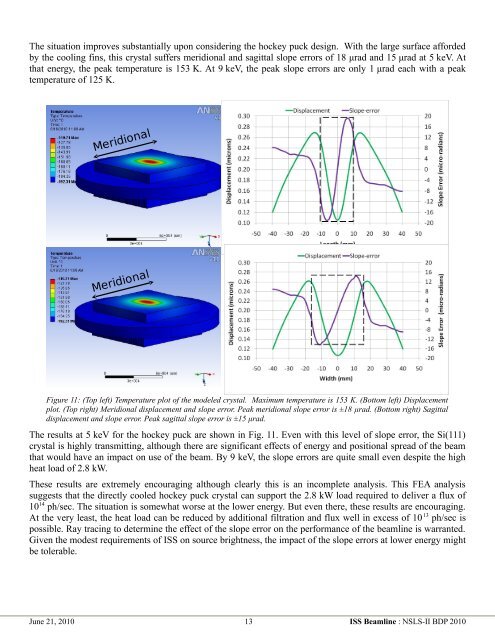Inner Shell Spectroscopy (ISS) - Brookhaven National Laboratory
Inner Shell Spectroscopy (ISS) - Brookhaven National Laboratory
Inner Shell Spectroscopy (ISS) - Brookhaven National Laboratory
Create successful ePaper yourself
Turn your PDF publications into a flip-book with our unique Google optimized e-Paper software.
The situation improves substantially upon considering the hockey puck design. With the large surface afforded<br />
by the cooling fins, this crystal suffers meridional and sagittal slope errors of 18 μrad and 15 μrad at 5 keV. At<br />
that energy, the peak temperature is 153 K. At 9 keV, the peak slope errors are only 1 μrad each with a peak<br />
temperature of 125 K.<br />
Figure 11: (Top left) Temperature plot of the modeled crystal. Maximum temperature is 153 K. (Bottom left) Displacement<br />
plot. (Top right) Meridional displacement and slope error. Peak meridional slope error is ±18 μrad. (Bottom right) Sagittal<br />
displacement and slope error. Peak sagittal slope error is ±15 μrad.<br />
The results at 5 keV for the hockey puck are shown in Fig. 11. Even with this level of slope error, the Si(111)<br />
crystal is highly transmitting, although there are significant effects of energy and positional spread of the beam<br />
that would have an impact on use of the beam. By 9 keV, the slope errors are quite small even despite the high<br />
heat load of 2.8 kW.<br />
These results are extremely encouraging although clearly this is an incomplete analysis. This FEA analysis<br />
suggests that the directly cooled hockey puck crystal can support the 2.8 kW load required to deliver a flux of<br />
10 14 ph/sec. The situation is somewhat worse at the lower energy. But even there, these results are encouraging.<br />
At the very least, the heat load can be reduced by additional filtration and flux well in excess of 10 13 ph/sec is<br />
possible. Ray tracing to determine the effect of the slope error on the performance of the beamline is warranted.<br />
Given the modest requirements of <strong>ISS</strong> on source brightness, the impact of the slope errors at lower energy might<br />
be tolerable.<br />
June 21, 2010 13 <strong>ISS</strong> Beamline : NSLS-II BDP 2010
















